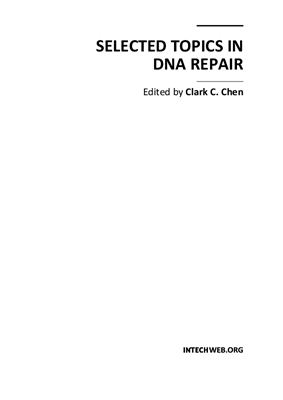InTech. 2011. 582 p.
This book is intended for students and scientists working in the field of DNA repair. Select topics in DNA repair are presented here to demonstrate how scientific ideas are developed, tested, dialogued, and matured as it is meant to discuss key concepts in DNA repair. The book should serve as a supplementary text in courses and seminars as well as a general reference for biologists with an interest in DNA repair.
Contents
Preface
DNA Damaging Agents
The DNA-Damage Response to Ionizing Radiation in Human Lymphocytes
Interactions by Carcinogenic Metal Compounds with DNA Repair Processes
Effect of Oxidative Stress on DNA Repairing Genes
UV Damaged DNA Repair & Tolerance in Plants
DNA Helix Destabilization by Alkylating Agents: From Covalent Bonding to DNA Repair
DNA Damage Caused by Polycyclic Aromatic Hydrocarbons: Mechanisms and Markers
DNA Repair: Lessons from the Evolution of Ionizing-Radiation-Resistant Prokaryotes – Fact and Theory
Involvement of Non-Homologous End-Joining in Radiation-Induced Genomic Instability
Mechanistic Insights
Role of RPA Proteins in Radiation Repair and Recovery
Recognition and Repair Pathways of Damaged DNA in Higher Plants
DNA Damage Protection and Induction of Repair by Dietary Phytochemicals and Cancer Prevention: What Do We Know?
The Nuclear Compartmentation of Glutathione: Effect on Cell Cycle Progression
Role for PKC? on Apoptosis in the DNA Damage Response
New Players in Recognition of Intact and Cleaved AP Sites: Implication in DNA Repair in Mammalian Cells
Methods in DNA Repair
SiDNA and Other Tools for the Indirect Induction of DNA Damage Responses
DNA Repair in Pathogenic Eukaryotic Cells: Insights from Comparative Genomics of Parasitic Protozoan
Mechanisms of Mutagenic DNA Nucleobase Damages and Their Chemical and Enzymatic Repairs Investigated by Quantum Chemical Methods
Insights into Therapeutic Strategies
DNA Radiosensitization: The Search for Repair Refractive Lesions Including Double Strand Breaks and Interstrand Crosslinks
The Influence of Individual Genome Sensitivity in DNA Damage Repair Assessment in Chronic Professional Exposure to Low Doses of Ionizing Radiation
Application of Host Cell Reactivation in Evaluating the Effects of Anticancer Drugs and Environmental Toxicants on Cellular DNA Repair Activity in Head and Neck Cancer
Role of Radioprotectors in the Inhibition of DNA Damage and Modulation of DNA Repair After Exposure to Gamma-Radiation
DNA-Binding Radioprotectors
DNA Damage Response and Repair: Insights into Strategies for Radiation Sensitization
The Botanical Extract Feverfew PFE Reduces DNA Damage and Induces DNA Repair Processes
Food Factors and Oxidative DNA Damage / DNA Repair Systems
Enhancing DNA Repair by Combining only Dietary Supplement Ingredients that do not Metabolically Compete in Order to Achieve Synergism
This book is intended for students and scientists working in the field of DNA repair. Select topics in DNA repair are presented here to demonstrate how scientific ideas are developed, tested, dialogued, and matured as it is meant to discuss key concepts in DNA repair. The book should serve as a supplementary text in courses and seminars as well as a general reference for biologists with an interest in DNA repair.
Contents
Preface
DNA Damaging Agents
The DNA-Damage Response to Ionizing Radiation in Human Lymphocytes
Interactions by Carcinogenic Metal Compounds with DNA Repair Processes
Effect of Oxidative Stress on DNA Repairing Genes
UV Damaged DNA Repair & Tolerance in Plants
DNA Helix Destabilization by Alkylating Agents: From Covalent Bonding to DNA Repair
DNA Damage Caused by Polycyclic Aromatic Hydrocarbons: Mechanisms and Markers
DNA Repair: Lessons from the Evolution of Ionizing-Radiation-Resistant Prokaryotes – Fact and Theory
Involvement of Non-Homologous End-Joining in Radiation-Induced Genomic Instability
Mechanistic Insights
Role of RPA Proteins in Radiation Repair and Recovery
Recognition and Repair Pathways of Damaged DNA in Higher Plants
DNA Damage Protection and Induction of Repair by Dietary Phytochemicals and Cancer Prevention: What Do We Know?
The Nuclear Compartmentation of Glutathione: Effect on Cell Cycle Progression
Role for PKC? on Apoptosis in the DNA Damage Response
New Players in Recognition of Intact and Cleaved AP Sites: Implication in DNA Repair in Mammalian Cells
Methods in DNA Repair
SiDNA and Other Tools for the Indirect Induction of DNA Damage Responses
DNA Repair in Pathogenic Eukaryotic Cells: Insights from Comparative Genomics of Parasitic Protozoan
Mechanisms of Mutagenic DNA Nucleobase Damages and Their Chemical and Enzymatic Repairs Investigated by Quantum Chemical Methods
Insights into Therapeutic Strategies
DNA Radiosensitization: The Search for Repair Refractive Lesions Including Double Strand Breaks and Interstrand Crosslinks
The Influence of Individual Genome Sensitivity in DNA Damage Repair Assessment in Chronic Professional Exposure to Low Doses of Ionizing Radiation
Application of Host Cell Reactivation in Evaluating the Effects of Anticancer Drugs and Environmental Toxicants on Cellular DNA Repair Activity in Head and Neck Cancer
Role of Radioprotectors in the Inhibition of DNA Damage and Modulation of DNA Repair After Exposure to Gamma-Radiation
DNA-Binding Radioprotectors
DNA Damage Response and Repair: Insights into Strategies for Radiation Sensitization
The Botanical Extract Feverfew PFE Reduces DNA Damage and Induces DNA Repair Processes
Food Factors and Oxidative DNA Damage / DNA Repair Systems
Enhancing DNA Repair by Combining only Dietary Supplement Ingredients that do not Metabolically Compete in Order to Achieve Synergism

